Feasibility Analysis of Polyurethane-Prepolymer-Modified Bitumen Used for Fully Reclaimed Asphalt Pavement (FRAP)
Abstract
:1. Introduction
2. Materials and Methods
2.1. Raw Materials
2.1.1. Virgin Asphalt
2.1.2. Polyurethane Prepolymer
2.1.3. Chain Extender
2.1.4. Compatibilizer
2.1.5. RAP Mixture
2.2. Sample Preparation
2.2.1. Preparation Methods of Bitumen
2.2.2. Mixing Method of FRAP Mixture
2.3. Test Methods
2.3.1. Brookfield Rotational Viscosity Test
2.3.2. Tensile Property Test
2.3.3. The Marshall Test
2.3.4. Segregation Test
2.3.5. Dynamic Shear Rheometer Test
3. Results
3.1. Design of Raw Materials Parameters
3.1.1. PUP and Chain Extender
Primary Selection of the Chain Extender Content
Principles and Methods for PUP and Chain Extender Content Determination
PUP and Chain Extender Content Determination
3.1.2. Compatibilizer
3.2. Study on Rheological Properties of PPB
3.2.1. Frequency Sweep Test Results
3.2.2. Temperature Sweep TEST results
3.3. Study on Tensile Properties of PPB
3.4. Economic Cost Impact Evaluation
4. Conclusions
- (a)
- The PPB was obtained by chemical synthesis containing simply raw materials whose preparation process has the advantages of relatively low shearing temperature, short time, and good compatibility between virgin asphalt and modifiers. The appropriate formula of PPB binder is determined, i.e., virgin asphalt binder: PUP: chain extender: compatibilizer = 100:60:15.6:3;
- (b)
- In terms of the rheological properties, the addition of PUP significantly improved the elastic recovery performance, high-temperature permanent deformation resistance, and temperature sensitivity of asphalt but weakened the influence on fatigue resistance;
- (c)
- The great tensile properties of the PPB binder result from the crosslinking network structure formed by PUP resin curing. The network structure makes asphalt has better pavement performance which is conducive to forming strength;
- (d)
- The PPB mixtures containing 100% RAP show potential cost-saving benefits compared to epoxy asphalt mixtures. The unit price of PPB binder is 77.30% of that of epoxy asphalt binder, and the utilization of RAP further reduces the cost of raw materials. This demonstrates its suitability for fully reclaimed asphalt pavement applications, where the application of recycled materials is maximized.
Author Contributions
Funding
Institutional Review Board Statement
Informed Consent Statement
Data Availability Statement
Conflicts of Interest
References
- Shao, H.; Sun, L.; Liu, L.; You, Z.; Yang, X. A novel double-drum mixing technique for plant hot mix asphalt recycling with high reclaimed asphalt pavement content and rejuvenator. Constr. Build. Mater. 2017, 134, 236–244. [Google Scholar] [CrossRef]
- Ho, C.H.; Tahami, S.A.; Mirhosseini, S.; Dessouky, S.; Hoff, I. Performance evaluation of asphalt mixtures containing high-RAP binder content and bio-oil rejuvenator. Constr. Build. Mater. 2019, 227, 116465. [Google Scholar]
- Yi, X.; Dong, R.; Tang, N. Development of a novel binder rejuvenator composed by waste cooking oil and crumb tire rubber. Constr. Build. Mater. 2020, 236, 117621. [Google Scholar] [CrossRef]
- Cui, Q.; Zhu, X. Green Contracting in Highway Construction State of the Practice. Transport. Res. Rec. 2011, 2228, 11–18. [Google Scholar] [CrossRef]
- Franke, R.; Ksaibati, K. A methodology for cost-benefit analysis of recycled asphalt pavement (RAP) in various highway applications. Int. J. Pavement. Eng. 2015, 16, 660–666. [Google Scholar] [CrossRef]
- Chou, C.-P.; Lee, N. A Sensitivity Study of RAP Cost and Performance on Its Life Cycle Benefits. In Proceedings of the 8th International Conference on Road and Airfield Pavement Technology (ICPT), Taipei, China, 14–18 July 2013. [Google Scholar]
- Mogawer, W.; Bennert, T.; Daniel, J.S.; Bonaquist, R.; Austerman, A.; Booshehrian, A. Performance characteristics of plant produced high RAP mixtures. Road. Mater. Pavement. 2012, 13, 183–208. [Google Scholar] [CrossRef]
- Sharma, A.; Rongmei Naga, G.R.; Kumar, P.; Rai, P. Mix design, development, production and policies of recycled hot mix asphalt: A review. J. Traffic. Transp. Eng. 2022, 9, 765–794. [Google Scholar] [CrossRef]
- Ma, T.; Wang, H.; Zhao, Y.; Huang, X.; Pi, Y. Strength Mechanism and Influence Factors for Cold Recycled Asphalt Mixture. Adv. Mater. Sci. Eng. 2015, 2015, 181853. [Google Scholar] [CrossRef]
- Islam, R.M.; Mannan, U.A.; Rahman, A.A.; Tarefder, R.A. Effects of Recycled Asphalt Pavement on Mix and Binder Properties and Performance in the Laboratory. J. Mater. Civil. Eng. 2014, 22, 643–650. [Google Scholar]
- Ma, Z.; Liu, H.; Yuan, R.; Zhang, D.; Peng, Z.; Liu, G. Study on fatigue resistance of micro surfacing of RAP based on Weibull distribution. J. Munic. Technol. 2023, 41, 16–23. [Google Scholar]
- Li, J.; Huang, X.; Zhang, Y.; Xu, M. Bitumen Colloidal and Structural Stability Characterization. Road Mater. Pavement Des. 2009, 10, 45–59. [Google Scholar] [CrossRef]
- Peterson, G.D.; Davison, R.R.; Glover, C.J.; Bullin, J.A. Effect of composition on asphalt recycling agent performance. Transport. Res. Rec. 1994, 38–46. Available online: https://api.semanticscholar.org/CorpusID:92887155 (accessed on 12 July 2023).
- Taha, R.; Ali, G.; Basma, A.; Al-Turk, O. Evaluation of Reclaimed Asphalt Pavement Aggregate in Road Bases and Subbases. Transport. Res. Rec. 1999, 1652, 264–269. [Google Scholar] [CrossRef]
- Guo, M.; Liu, H.; Jiao, Y.; Mo, L.; Tan, Y.; Wang, D.; Liang, M. Effect of WMA-RAP technology on pavement performance of asphalt mixture: A state-of-the-art review. J. Clean. Prod. 2020, 266, 121704. [Google Scholar] [CrossRef]
- Ingrassia, L.P.; Spadoni, S.; Ferrotti, G.; Virgili, A.; Canestrari, F. Prediction of the Long-Term Performance of an Existing Warm Recycled Motorway Pavement. Materials 2023, 16, 16031005. [Google Scholar] [CrossRef] [PubMed]
- Ingrassia, L.P.; Cardone, F.; Ferrotti, G.; Canestrari, F. Monitoring the evolution of the structural properties of warm recycled pavements with Falling Weight Deflectometer and laboratory tests. Road Mater. Pavement Des. 2021, 22, S69–S82. [Google Scholar] [CrossRef]
- Pei, Z.; Yi, J.; Xu, M.; Ai, X.; Cao, J.; Hu, W.; Gao, L.; Feng, D. Exploration of the design theory of crack-resistant rejuvenator for warm-mix recycled asphalt mixtures with high RAP contents. J. Clean. Prod. 2023, 388, 135855. [Google Scholar] [CrossRef]
- Yousefi, A.; Behnood, A.; Nowruzi, A.; Haghshenas, H. Performance evaluation of asphalt mixtures containing warm mix asphalt (WMA) additives and reclaimed asphalt pavement (RAP). Constr. Build. Mater. 2021, 268, 121200. [Google Scholar] [CrossRef]
- Quagliano Amado, J.C.; Ross, P.G.; Mattos Silva Murakami, L.; Narciso Dutra, J.C. Properties of Hydroxyl-Terminal Polybutadiene (HTPB) and Its Use as a Liner and Binder for Composite Propellants: A Review of Recent Advances. Propell. Explos. Pyrot. 2022, 47, 202100283. [Google Scholar] [CrossRef]
- Yang, T.; He, Z.; Huang, G.; Zhao, Y.; Fu, J.; Xiang, H.; Zhou, Y. Study on materials composition and process parameters of polyurethane-modified asphalt synthesized in-situ by the one-shot process. Constr. Build. Mater. 2023, 374, 130661. [Google Scholar] [CrossRef]
- Cho, J.W.; Jung, Y.C.; Lee, S.H.; Chun, B.C.; Chung, Y.C. Characterization and mechanical properties of prepolymer and polyurethane block copolymer with a shape memory effect. Fiber. Polym. 2003, 4, 114–118. [Google Scholar] [CrossRef]
- Tomic, N.Z.; Marinkovic, A.D.; Balanc, B.; Obradovic, V.; Pavlovic, V.; Manojlovic, V.; Vuksanovic, M.M. High-performance laminate material based on polyurethane and epoxide reinforced by silica particles from rice husk used for intelligent pedestrian crossings. Iran. Polym. J. 2021, 30, 319–330. [Google Scholar] [CrossRef]
- Cong, P.; Zhang, A.; Ge, W.; Cheng, Y. Study on macroscopic properties and microstructure of thermosetting polyurethane asphalt binder (PAB) based on curing kinetics. Constr. Build. Mater. 2022, 333, 127347. [Google Scholar] [CrossRef]
- Cong, L.; Yang, F.; Guo, G.; Ren, M.; Shi, J.; Tan, L. The use of polyurethane for asphalt pavement engineering applications: A state-of-the-art review. Constr. Build. Mater. 2019, 225, 1012–1025. [Google Scholar] [CrossRef]
- Yang, F.; Gong, H.; Cong, L.; Shi, J.; Guo, G.; Mei, Z. Investigating on polymerization process and interaction mechanism of thermosetting polyurethane modified asphalt. Constr. Build. Mater. 2022, 335, 127261. [Google Scholar] [CrossRef]
- Gong, X.; Liu, Q.; Wang, H.; Wan, P.; Chen, S.; Wu, J.; Wu, S. Synthesis of environmental-curable CO2-based polyurethane and its enhancement on properties of asphalt binder. J. Clean. Prod. 2023, 384, 135576. [Google Scholar] [CrossRef]
- Xia, L.; Cao, D.; Zhang, H.; Guo, Y. Study on the classical and rheological properties of castor oil-polyurethane pre polymer (C-PU) modified asphalt. Constr. Build. Mater. 2016, 112, 949–955. [Google Scholar] [CrossRef]
- Xu, C.; Zhang, Z.; Zhao, F.; Liu, F.; Wang, J. Improving the performance of RET modified asphalt with the addition of polyurethane prepolymer (PUP). Constr. Build. Mater. 2019, 206, 560–575. [Google Scholar] [CrossRef]
- Zhang, Z.; Sun, J.; Huang, Z.; Wang, F.; Jia, M.; Lv, W.; Ye, J. A laboratory study of epoxy/polyurethane modified asphalt binders and mixtures suitable for flexible bridge deck pavement. Constr. Build. Mater. 2021, 274, 122084. [Google Scholar] [CrossRef]
- Huang, W.; Guo, W.; Wei, Y. Prediction of Paving Performance for Epoxy Asphalt Mixture by Its Time- and Temperature-Dependent Properties. J. Mater. Civ. Eng. 2020, 32, 04020017. [Google Scholar] [CrossRef]
- Yi, X.; Chen, H.; Wang, H.; Shi, C.; Yang, J. The feasibility of using epoxy asphalt to recycle a mixture containing 100% reclaimed asphalt pavement (RAP). Constr. Build. Mater. 2022, 319, 126122. [Google Scholar] [CrossRef]
- JTG E20-2011; Standard Test Methods of Bitumen and Bituminous Mixtures for Highway Engineering. China Communications Press: Beijing, China, 2011.
- Zhang, H.L.; Zhang, G.W.; Han, F.F.; Zhang, Z.P.; Lv, W.J. A lab study to develop a bridge deck pavement using bisphenol A unsaturated polyester resin modified asphalt mixture. Constr. Build. Mater. 2018, 159, 83–98. [Google Scholar] [CrossRef]
- GB/T 30598-2014; General Specifications of Epoxy Asphalt Materials for Paving Roads and Bridges. Standards Press of China: Beijing, China, 2014.
- Hong, B.; Lu, G.; Gao, J.; Dong, S.; Wang, D. Green tunnel pavement: Polyurethane ultra-thin friction course and its performance characterization. J. Clean. Prod. 2021, 289, 125131. [Google Scholar] [CrossRef]
- Xian, G.; Guo, R.; Li, C.; Hong, B. Mechanical properties of carbon/glass fiber reinforced polymer plates with sandwich structure exposed to freezing-thawing environment: Effects of water immersion, bending loading and fiber hybrid mode. Mech. Adv. Mater. Struc. 2022, 30, 814–834. [Google Scholar] [CrossRef]
- Wu, J.; Zhu, Y.; Li, C. Experimental investigation of fatigue capacity of bending-anchored CFRP cables. Polymers 2023, 15, 2483. [Google Scholar] [CrossRef] [PubMed]
- ASTM D638-10; Standard Test Methods for Tensile Properties of Plastics. ASTM International: West Conshohocken, PA, USA, 2010.
- T315-12; Standard Method of Test for Determining the Rheological Properties of Asphalt Binder Using a Dynamic Shear Rheometer (DSR). AASHTO: Washington, DC, USA, 2004.
- Huang, J.; Xiong, Y.; Zhou, X.; Yang, Z.; Yuan, T. A novel polyfunctional polyurethane acrylate prepolymer derived from bio-based polyols for UV-curable coatings applications. Polym. Test. 2022, 106, 107439. [Google Scholar] [CrossRef]
- Feng, Y.; Man, L.; Hu, Y.; Chen, L.; Xie, B.; Zhang, C.; Yuan, T.; Yang, Z. One-pot synthesis of polyurethane-imides with tailored performance from castor and tung oil. Prog. Org. Coat. 2019, 132, 62–69. [Google Scholar] [CrossRef]
- Motta, J.; Qaderi, S.; Farina, I.; Singh, N.; Amendola, A.; Fraternali, F. Experimental characterization and mechanical modeling of additively manufactured TPU components of innovative seismic isolators. Acta. Mech. 2022. [Google Scholar] [CrossRef]
- Xian, G.; Guo, R.; Li, C.; Wang, Y. Mechanical performance evolution and life prediction of prestressed CFRP plate exposed to hygrothermal and freeze-thaw environments. Compos. Struct. 2022, 293, 115719. [Google Scholar] [CrossRef]
- Zheng, W.; Wang, H.; You, Z.; Shao, L.; Golroo, A.; Chen, Y. Mechanism and rheological characterization of MDI modified Wood-Based Bio-Oil asphalt. Constr. Build. Mater. 2021, 309, 125113. [Google Scholar] [CrossRef]
- Zhang, Z.; Sun, J.; Jia, M.; Qi, B.; Zhang, H.; Lv, W.; Mao, Z.; Chang, P.; Peng, J.; Liu, Y. Study on a thermosetting polyurethane modified asphalt suitable for bridge deck pavements: Formula and properties. Constr. Build. Mater. 2020, 241, 118122. [Google Scholar] [CrossRef]
- Li, Z.; Yang, F.; Yuan, J.; Cong, L.; Yu, M. Study on preparation and pavement performance of polyurethane modified asphalt based on in-situ synthesis method. Constr. Build. Mater. 2021, 309, 125196. [Google Scholar] [CrossRef]
- Li, D. Research on properties of polyurethane precursor/SBS composite modified asphalt and mixture. J. Munic. Technol. 2023, 41, 29–34. [Google Scholar]
- Gong, X.; Liu, Q.; Wan, P.; Chen, S.; Wang, H.; Wu, J.; Wu, S. A comparative study of the properties CO2-based polyurethane modified asphalts prepared by prepolymer and in-situ polymerization methods. Constr. Build. Mater. 2023, 364, 129958. [Google Scholar] [CrossRef]
- Li, X.; Li, J.; Wang, J.; Yuan, J.; Jiang, F.; Yu, X.; Xiao, F. Recent applications and developments of Polyurethane materials in pavement engineering. Constr. Build. Mater. 2021, 304, 124639. [Google Scholar] [CrossRef]
- Zhang, F.; Zhang, L.; Muhammad, Y.; Cai, Z.; Guo, X.; Guo, Y.; Huang, K. Study on preparation and properties of new thermosetting epoxy asphalt. Constr. Build. Mater. 2021, 311, 125307. [Google Scholar] [CrossRef]
- Huang, G.; Yang, T.; He, Z.; Yu, L.; Xiao, H. Polyurethane as a modifier for road asphalt: A literature review. Constr. Build. Mater. 2022, 356, 129058. [Google Scholar] [CrossRef]
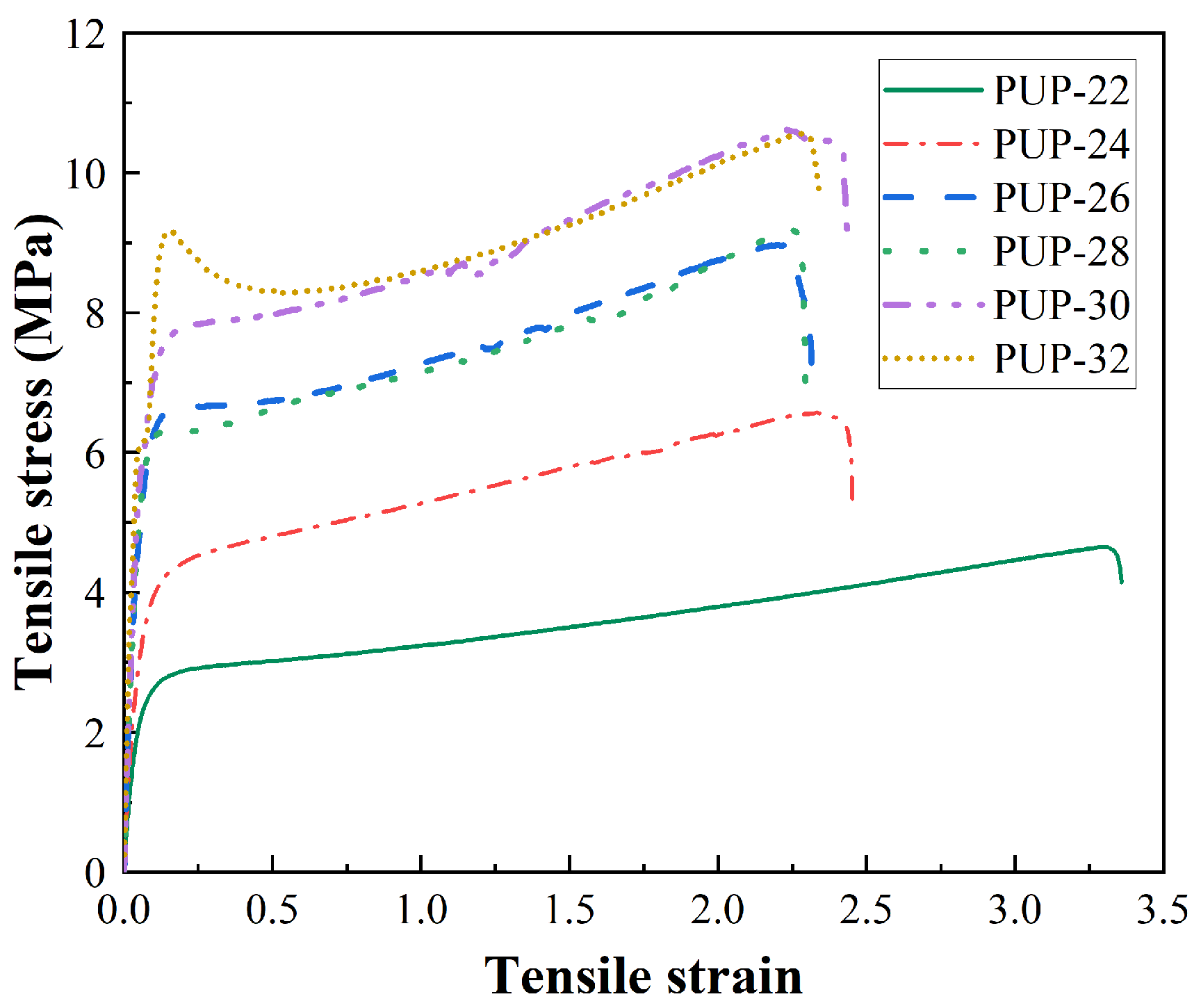
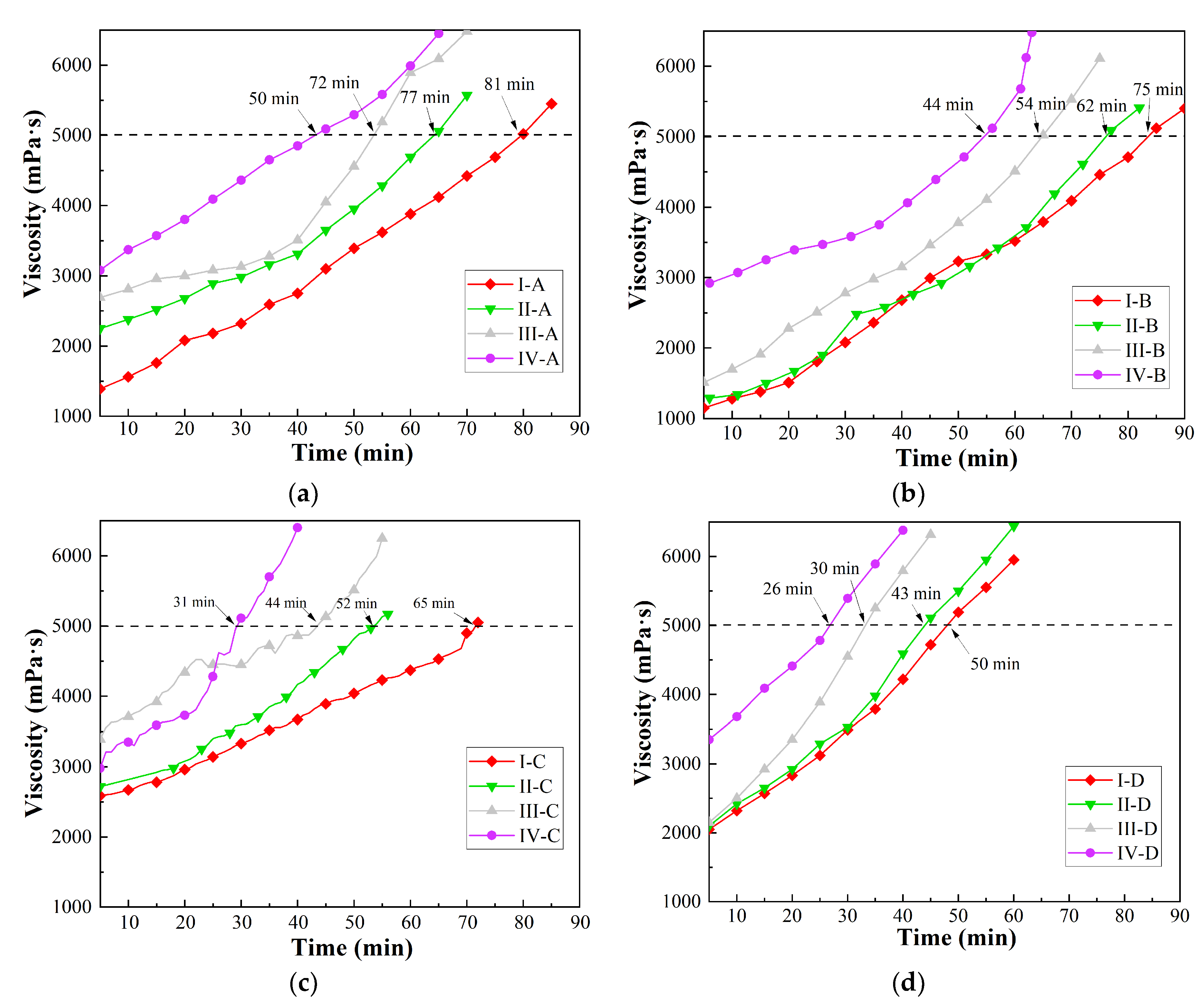
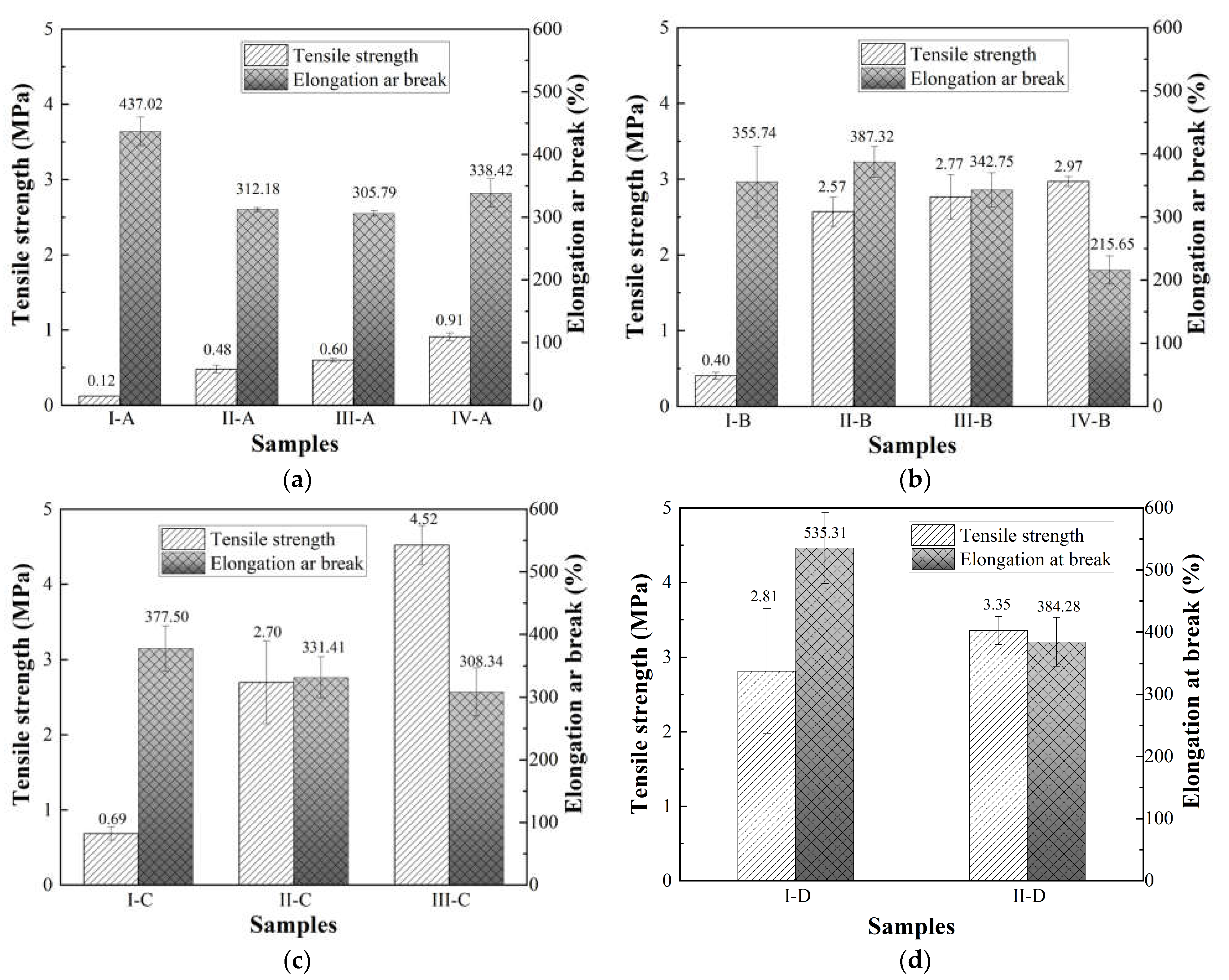

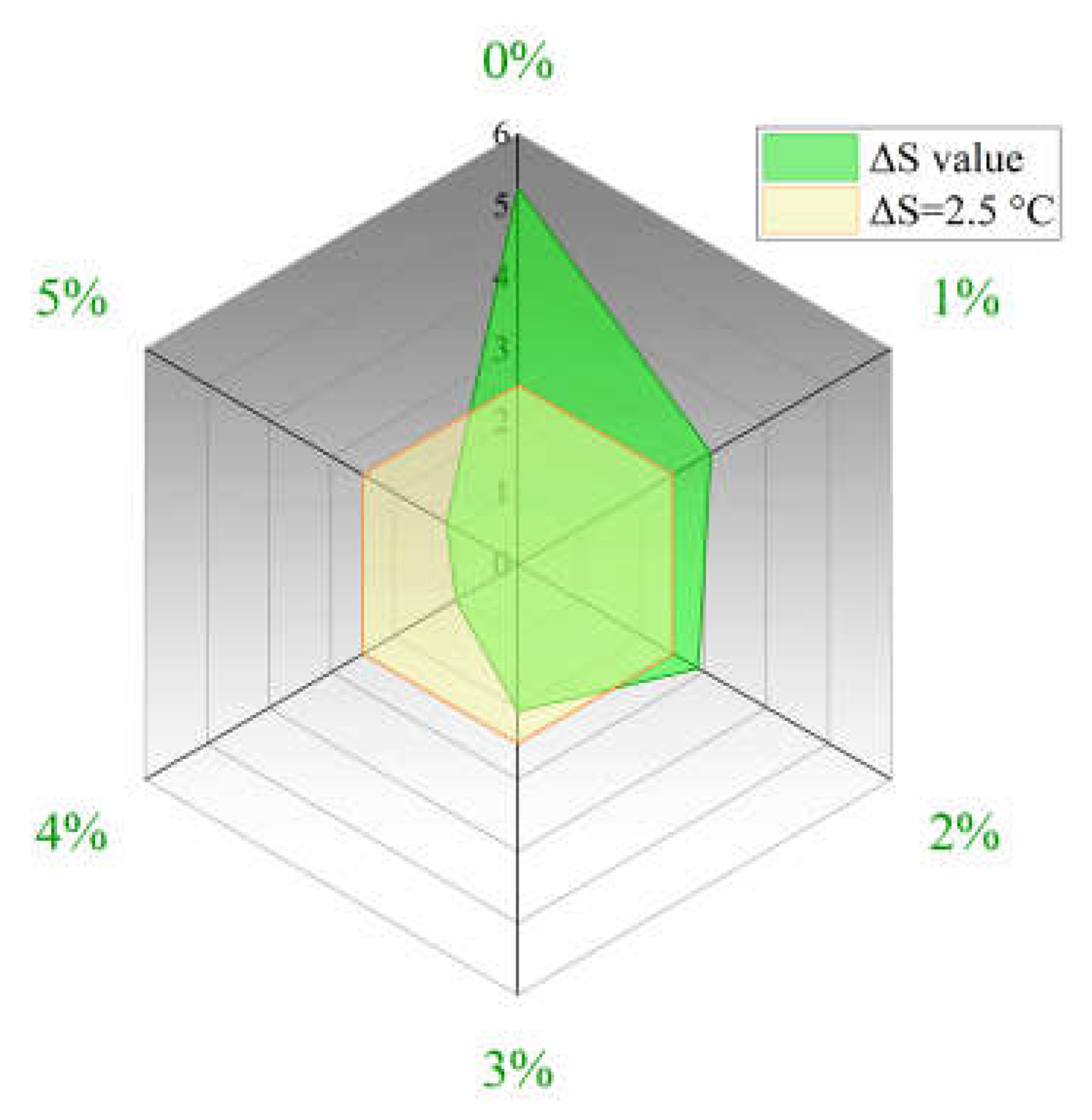
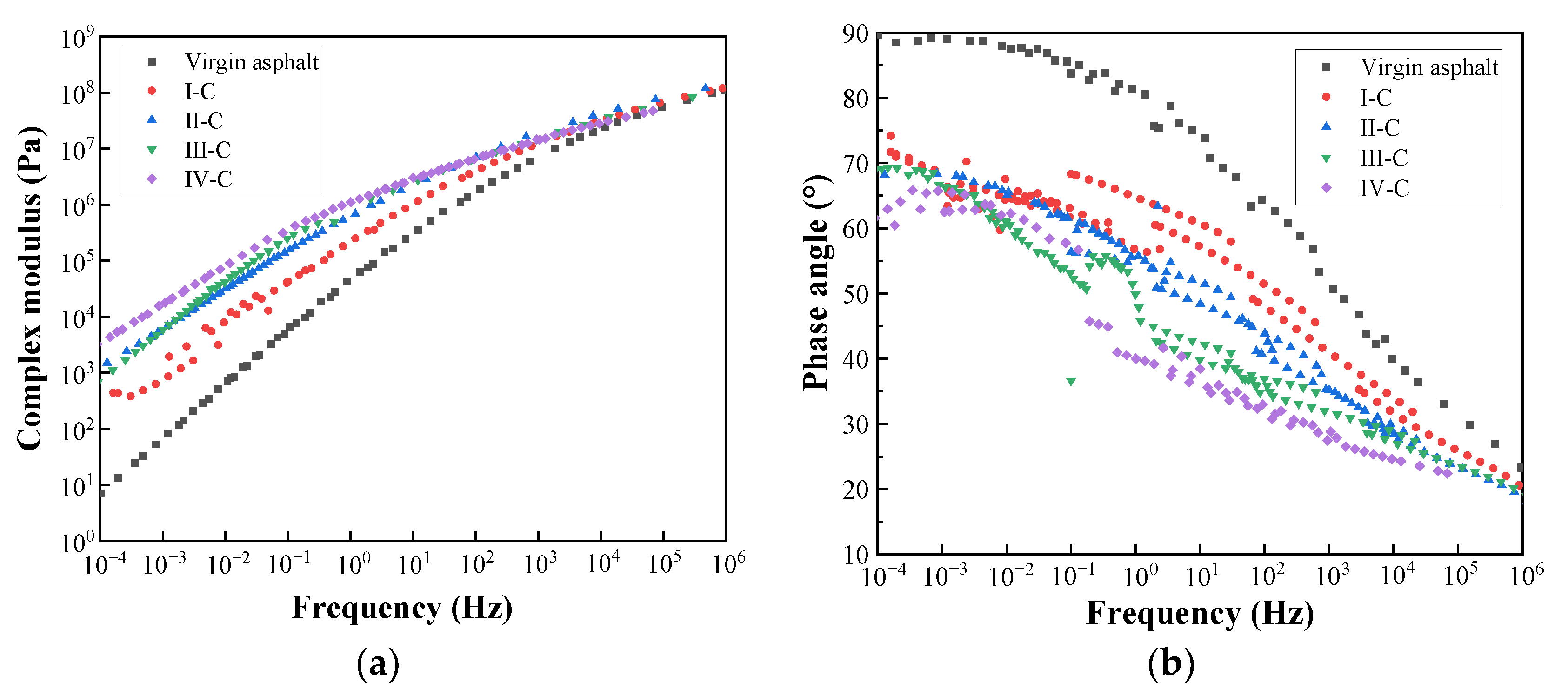
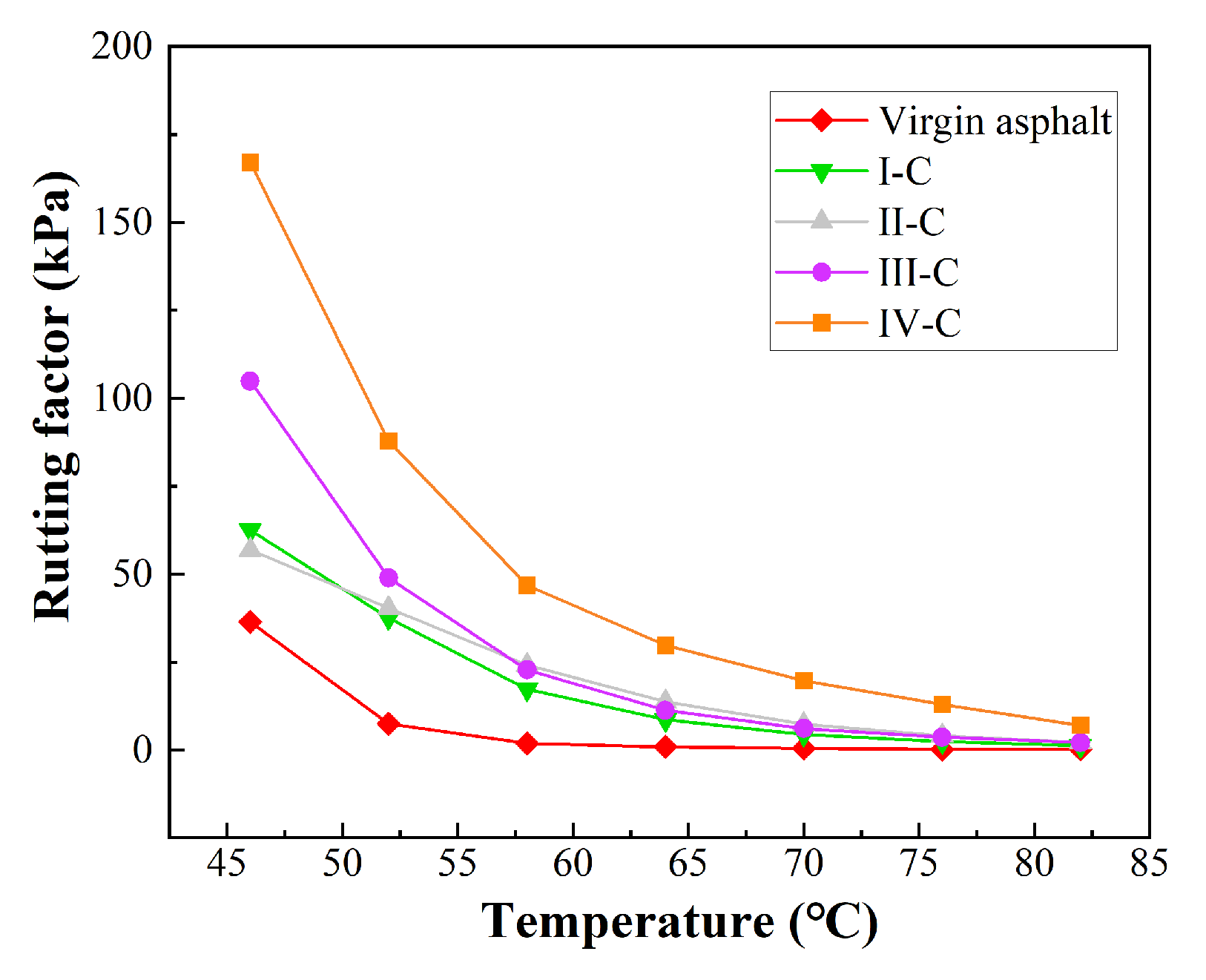
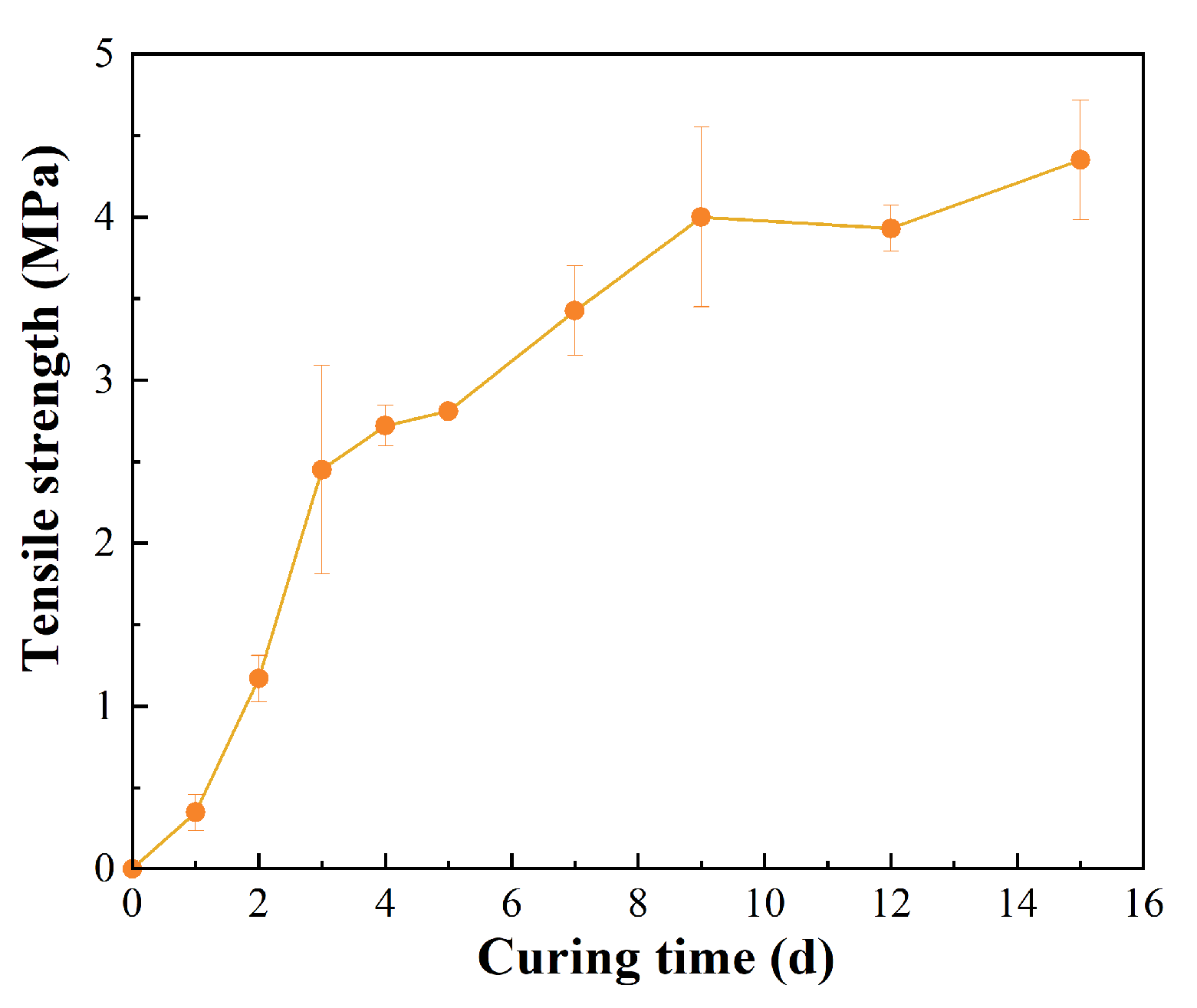

| Properties | Units | Measured Value | Requirement | Specification |
|---|---|---|---|---|
| Penetration | 0.1 mm | 80.3 | 80~100 | T 0604-2011 |
| Softening point | °C | 48.4 | ≥46 | T 0606-2011 |
| Ductility (15 °C) | cm | 143 | ≥100 | T 0605-2011 |
| Viscosity (135 °C) | mPa·s | 413 | Measured records | T 0620-2011 |
| Mass loss after TFOT | % | −0.69 | ≤±0.8 | T 0610-2011 |
| Properties | Units | Results |
|---|---|---|
| Appearance | / | Transparent |
| Viscosity (25 °C) | mPa·s | 2200~3200 |
| Density | g/cm3 | 1.05~1.10 |
| –NCO content | % | 10.20~11.20 |
| Properties | Units | Results |
|---|---|---|
| Appearance | / | Dark amber liquid |
| Molecular formula | / | C30H30N2 |
| Molecular weight | / | 310.48 |
| Density | g/cm3 | 0.99 |
| Purity | % | 98.70 |
| MDA content | % | 0.01 |
| Moisture content | % | 0.018 |
| Properties | Units | Results |
| Appearance | / | White powder crystal |
| Melting point | °C | 54 |
| Boiling point | °C | 202 |
| Density | g/cm3 | 1.48 |
| No. | Tensile Strength/MPa | Elongation at Break/% | Tensile Modulus/MPa |
|---|---|---|---|
| PUP-22 | 5.14 ± 0.46 | 315.59 ± 32.67 | 16.70 ± 3.00 |
| PUP-24 | 8.47 ± 0.68 | 255.03 ± 6.95 | 28.61 ± 7.03 |
| PUP-26 | 8.72 ± 0.37 | 252.82 ± 39.16 | 33.37 ± 3.85 |
| PUP-28 | 9.73 ± 0.77 | 249.96 ± 29.45 | 34.78 ± 0.67 |
| PUP-30 | 10.42 ± 0.27 | 243.28 ± 40.33 | 40.46 ± 3.45 |
| PUP-32 | 10.81 ± 0.50 | 218.32 ± 26.19 | 42.60 ± 8.06 |
| Materials Types | Raw Materials | Formulation |
|---|---|---|
| Asphalt binder type | Virgin asphalt 498 $/t; PUP 2950 $/t; Chain extender 7669 $/t; Compatibilizer 1401 $/t; Epoxy resin 4268 $/t; Curing agent 5014 $/t; SBS 108.38 $/t; Crumb rubber 25.36 $/t. | PPB: virgin asphalt: PUP: chain extender: compatibilizer = 100:60:15.6:3; Epoxy asphalt: virgin asphalt: epoxy resin: curing agent = 100:58:42; SBS MA: virgin asphalt: SBS = 100:5; Crumb rubber MA: virgin asphalt: crumb rubber = 100:14. |
| Mixture type | PPB binder 1963.26 $/t; Aggregates 59 $/t; Mineral powder 23.6 $/t; RAP 0 $/t. | PPB/FRAP: 2.44%PPB, 97.56%RAP; PPB/AC-13: 5.66%PPB, 88.68%aggregates, 5.66%mineral powder; PPB/SMA-13: 5.66%PPB, 84.91%aggregates, 9.43%mineral powder. |
Disclaimer/Publisher’s Note: The statements, opinions and data contained in all publications are solely those of the individual author(s) and contributor(s) and not of MDPI and/or the editor(s). MDPI and/or the editor(s) disclaim responsibility for any injury to people or property resulting from any ideas, methods, instructions or products referred to in the content. |
© 2023 by the authors. Licensee MDPI, Basel, Switzerland. This article is an open access article distributed under the terms and conditions of the Creative Commons Attribution (CC BY) license (https://creativecommons.org/licenses/by/4.0/).
Share and Cite
Sun, M.; Wang, J.; Sun, H.; Hong, B. Feasibility Analysis of Polyurethane-Prepolymer-Modified Bitumen Used for Fully Reclaimed Asphalt Pavement (FRAP). Materials 2023, 16, 5686. https://doi.org/10.3390/ma16165686
Sun M, Wang J, Sun H, Hong B. Feasibility Analysis of Polyurethane-Prepolymer-Modified Bitumen Used for Fully Reclaimed Asphalt Pavement (FRAP). Materials. 2023; 16(16):5686. https://doi.org/10.3390/ma16165686
Chicago/Turabian StyleSun, Minggang, Jianling Wang, Hongpeng Sun, and Bin Hong. 2023. "Feasibility Analysis of Polyurethane-Prepolymer-Modified Bitumen Used for Fully Reclaimed Asphalt Pavement (FRAP)" Materials 16, no. 16: 5686. https://doi.org/10.3390/ma16165686
APA StyleSun, M., Wang, J., Sun, H., & Hong, B. (2023). Feasibility Analysis of Polyurethane-Prepolymer-Modified Bitumen Used for Fully Reclaimed Asphalt Pavement (FRAP). Materials, 16(16), 5686. https://doi.org/10.3390/ma16165686





